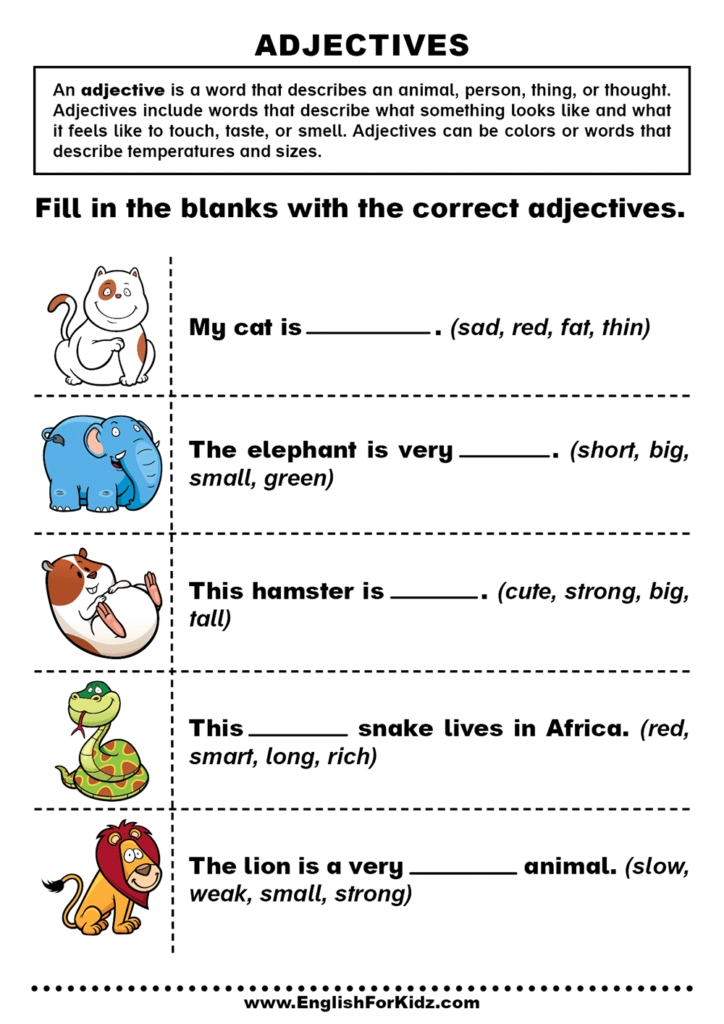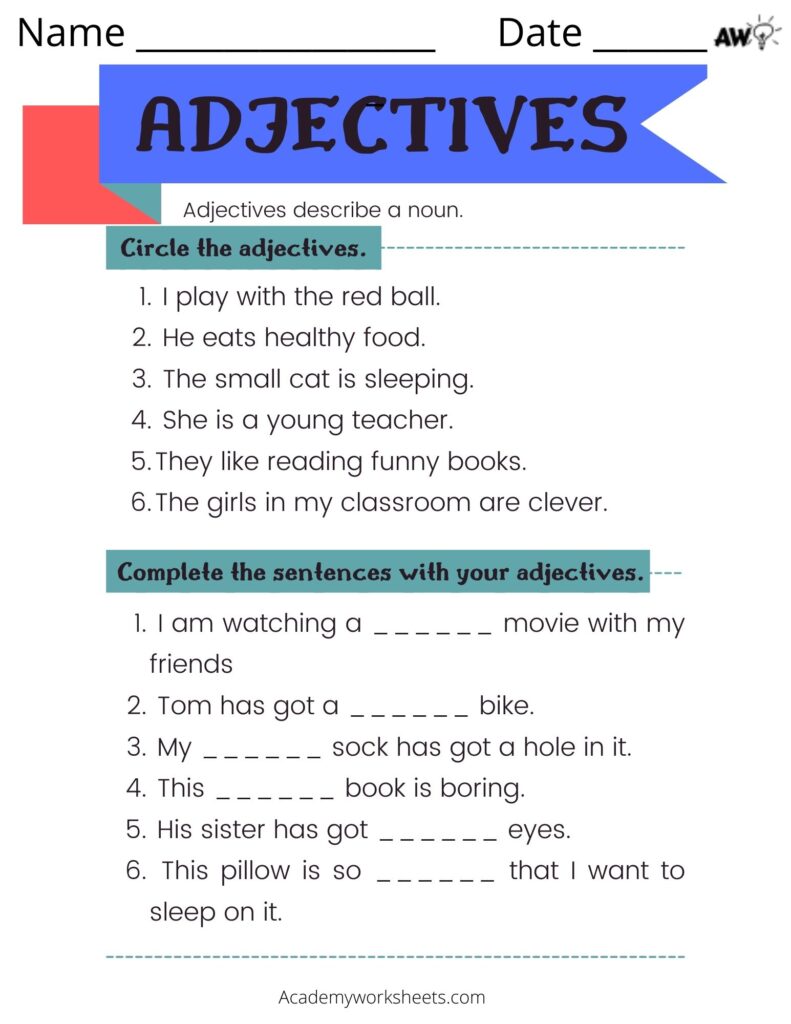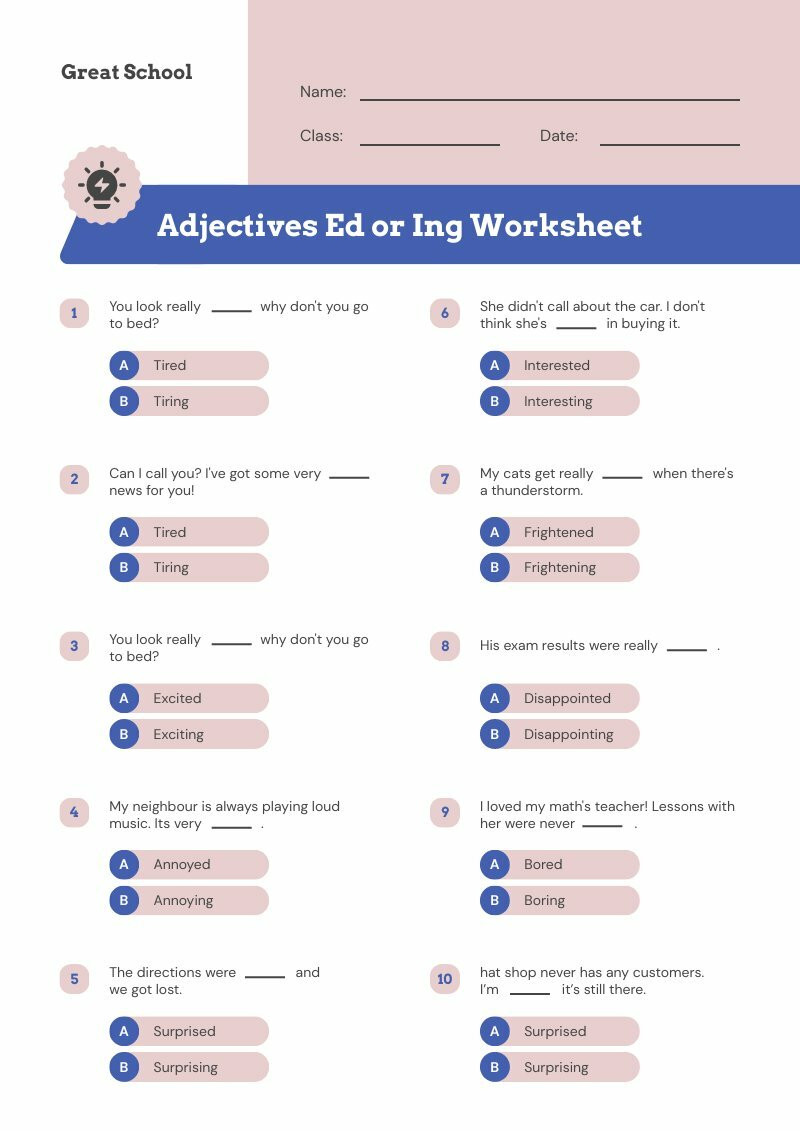
Mastering Descriptive Power: The Essential Role of Adjectives Worksheets K-12
Language is the canvas upon which we paint our thoughts, and adjectives are the vibrant colors that bring those paintings to life. They allow us to describe, qualify, and specify, transforming vague statements into vivid imagery. From a child learning to identify "big" and "small" to a high school student crafting compelling literary analysis, the journey of mastering adjectives is continuous and crucial. For educators and parents alike, adjectives worksheets K-12 serve as invaluable tools, providing structured practice and reinforcing understanding across all stages of a student’s linguistic development.
This comprehensive article delves into the pedagogical significance of adjectives, explores how worksheets evolve to meet the needs of different grade levels, and highlights best practices for leveraging these resources to cultivate strong descriptive skills from kindergarten through twelfth grade.
The Foundational Years: Adjectives Worksheets K-5

In the early elementary grades (Kindergarten through 5th grade), the primary goal is to introduce the concept of adjectives as "describing words." Students at this stage are naturally curious about the world around them, making adjectives an intuitive entry point into grammar.

Worksheet Focus:

- Identification: Simple exercises where students circle the adjective in a sentence or match an adjective to a picture it describes (e.g., "red" to an apple, "fuzzy" to a bear).
- Fill-in-the-Blanks: Providing sentences with a blank space and a word bank of adjectives for students to choose from (e.g., "The __ cat slept.").
- Sensory Adjectives: Worksheets that encourage students to think about how things look, sound, smell, feel, and taste. Activities might involve drawing something that is "loud" or listing adjectives for their favorite food.
- Size, Color, Shape, Number: Early worksheets often categorize adjectives by these easily observable qualities.
- Comparative and Superlative (Basic): Introducing the concept of comparing two items ("bigger") and three or more ("biggest") through simple examples and visual aids.


Pedagogical Approach: These worksheets should be highly visual, engaging, and often incorporate drawing or coloring. The emphasis is on understanding the function of adjectives – how they add detail and make sentences more interesting. Regular practice with adjectives worksheets K-12 at this early stage builds a solid foundation for future grammatical concepts.
Building Blocks: Adjectives Worksheets Grades 6-8

As students transition into middle school, their understanding of grammar needs to deepen. Adjectives become more complex, and students begin to differentiate them from other parts of speech, particularly adverbs. The focus shifts from simple identification to application and nuanced understanding.
Worksheet Focus:

- Identifying Adjectives in Context: Students analyze longer sentences or short paragraphs to identify adjectives and the nouns they modify. This helps them see adjectives within natural language.
- Adjectives vs. Adverbs: Worksheets designed specifically to help students distinguish between words that modify nouns (adjectives) and words that modify verbs, adjectives, or other adverbs (adverbs). This might involve choosing the correct word from a pair (e.g., "He runs quick/quickly").
- Degrees of Comparison (Advanced): More rigorous practice with comparative and superlative forms, including irregular adjectives (e.g., good, better, best; bad, worse, worst) and those requiring "more" and "most" (e.g., beautiful, more beautiful, most beautiful).
- Predicate Adjectives: Introducing the concept of adjectives that follow a linking verb and describe the subject (e.g., "The dog is fluffy.").
- Using Adjectives for Descriptive Writing: Worksheets that provide bland sentences and ask students to add vivid adjectives to improve them. This directly connects grammar to writing skills.
- Synonyms and Antonyms for Adjectives: Expanding vocabulary by exploring words with similar and opposite meanings.

Pedagogical Approach: Worksheets for middle schoolers should offer a mix of direct instruction and creative application. They should challenge students to think critically about word choice and its impact on meaning. The integration of adjectives worksheets K-12 into writing assignments becomes increasingly important at this level.
Mastery and Nuance: Adjectives Worksheets Grades 9-12
High school grammar instruction moves beyond basic identification to a sophisticated understanding of how adjectives contribute to style, meaning, and rhetorical effect. Students are expected to analyze authorial choices and employ a wide range of descriptive language in their own academic writing.
Worksheet Focus:
- Participial Adjectives: Identifying and using present participles (-ing) and past participles (-ed) as adjectives (e.g., "the running water," "the broken window").
- Compound Adjectives: Practice with hyphenated adjectives (e.g., "a well-known author," "a state-of-the-art facility").
- Order of Adjectives: Understanding the conventional order in which multiple adjectives should appear before a noun (e.g., "a small old red car" not "a red old small car").
- Connotative vs. Denotative Meanings: Exploring how adjectives can carry emotional or cultural associations beyond their literal definitions (e.g., "slender" vs. "skinny").
- Analyzing Author’s Use of Adjectives: Worksheets that present excerpts from literature and ask students to identify adjectives, explain their effect, and analyze how they contribute to tone, mood, or characterization.
- Avoiding Clichés and Overuse: Exercises that encourage students to replace overused or vague adjectives with more precise and original language.
- Figurative Language with Adjectives: Identifying and creating similes, metaphors, and personification that rely heavily on descriptive adjectives.
Pedagogical Approach: High school worksheets should encourage analytical thinking and critical engagement with language. They should prepare students for advanced academic writing and literary analysis. The role of adjectives worksheets K-12 at this stage is to refine existing knowledge and introduce the complexities of advanced descriptive language.
The Indispensable Role of Adjectives Worksheets K-12
Regardless of the grade level, well-designed worksheets offer a multitude of benefits in the teaching of adjectives:
- Structured Practice: They provide targeted, repetitive practice necessary for concept mastery.
- Reinforcement: Worksheets solidify concepts taught in direct instruction, allowing students to apply what they’ve learned independently.
- Diagnostic Tool: Teachers can quickly identify areas where students are struggling and adjust their instruction accordingly.
- Differentiation: Worksheets can be easily adapted to meet the needs of diverse learners, offering simpler versions for struggling students or more challenging tasks for advanced learners.
- Independent Learning: They empower students to work at their own pace and take ownership of their learning.
- Bridging Theory to Practice: Worksheets help students move beyond memorizing definitions to actively using adjectives in sentences and paragraphs.
Crafting Effective Adjectives Worksheets K-12
To maximize the impact of these valuable resources, educators should consider the following best practices:
- Clear Instructions: Ensure that directions are concise, unambiguous, and appropriate for the target age group.
- Varied Formats: Incorporate a mix of matching, circling, fill-in-the-blanks, sentence creation, and analytical questions to keep students engaged.
- Engaging Content: Use themes, characters, or scenarios that resonate with students’ interests.
- Real-World Context: Connect adjective usage to real-life situations, such as describing a favorite movie, a travel destination, or a personal experience.
- Progression and Scaffolding: Design worksheets that gradually increase in difficulty, building upon previously learned concepts. Provide examples or hints where necessary.
- Feedback Opportunities: Include answer keys for self-correction or design activities that lend themselves to peer review and teacher feedback.
- Integration with Other Skills: Encourage students to use adjectives in their creative writing, persuasive essays, and oral presentations.
Beyond the Worksheet: Holistic Learning
While adjectives worksheets K-12 are powerful tools, they are most effective when integrated into a broader, holistic language arts curriculum. Complementary activities can include:
- Interactive Games: Online quizzes, adjective charades, or "describe the object" games.
- Read-Alouds and Literary Analysis: Pointing out and discussing adjectives used by authors in books and stories.
- Descriptive Writing Tasks: Assigning creative writing prompts that specifically require the use of vivid adjectives.
- Peer Review: Students identify and suggest improvements for adjective usage in each other’s writing.
- Real-World Observation: Encouraging students to pay attention to the adjectives used in advertisements, news articles, or everyday conversations.
Conclusion
The journey of mastering adjectives is a cornerstone of linguistic development, empowering students to express themselves with precision, clarity, and creativity. From the foundational identification tasks in kindergarten to the sophisticated analytical exercises in high school, adjectives worksheets K-12 serve as consistent, reliable companions in this educational voyage. By providing structured practice, reinforcing concepts, and adapting to the evolving needs of learners, these resources play an indispensable role in cultivating generations of articulate and descriptive communicators. When used thoughtfully and integrated into a dynamic curriculum, adjectives worksheets K-12 are more than just grammar exercises; they are catalysts for rich and vibrant language acquisition.
